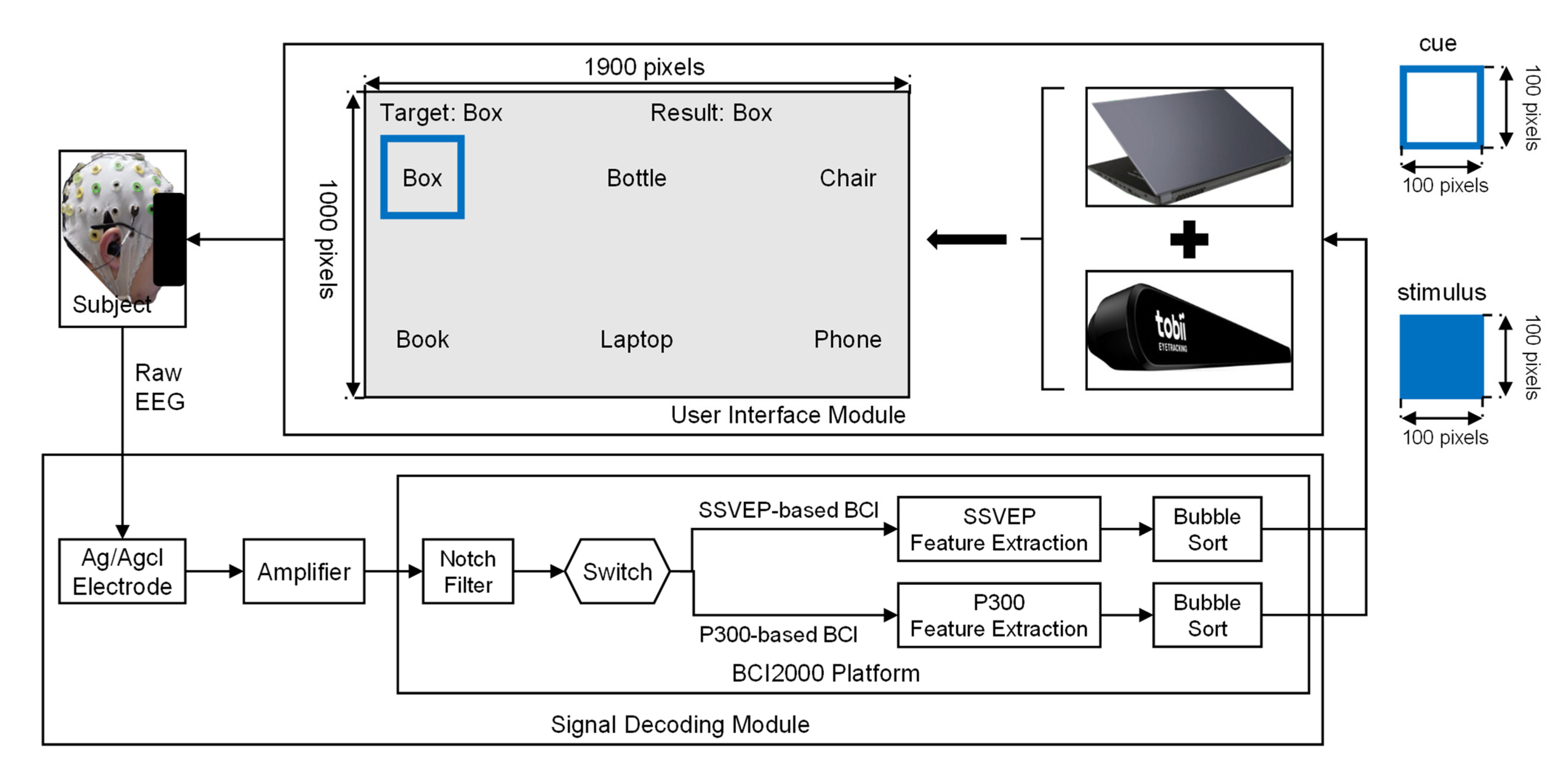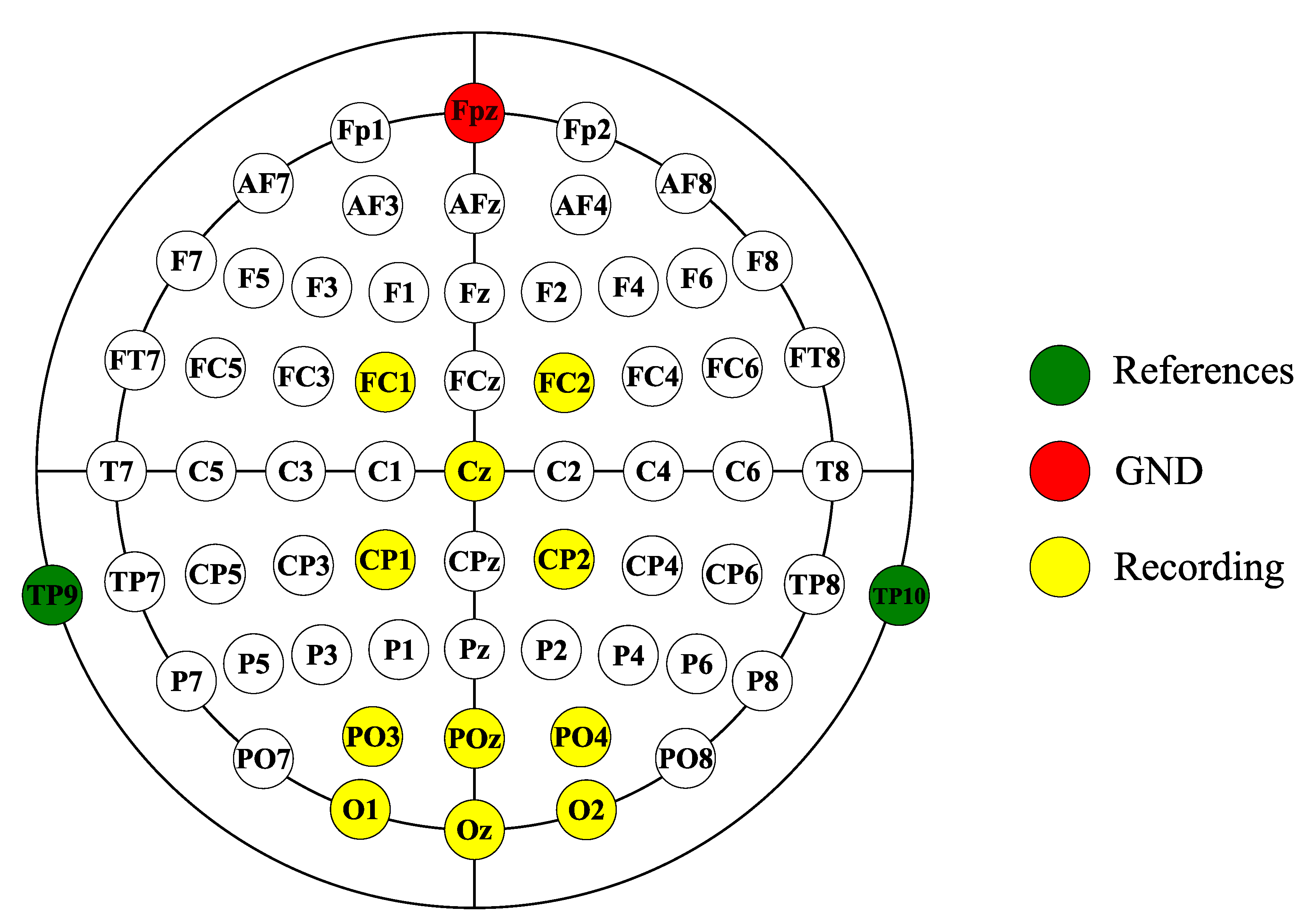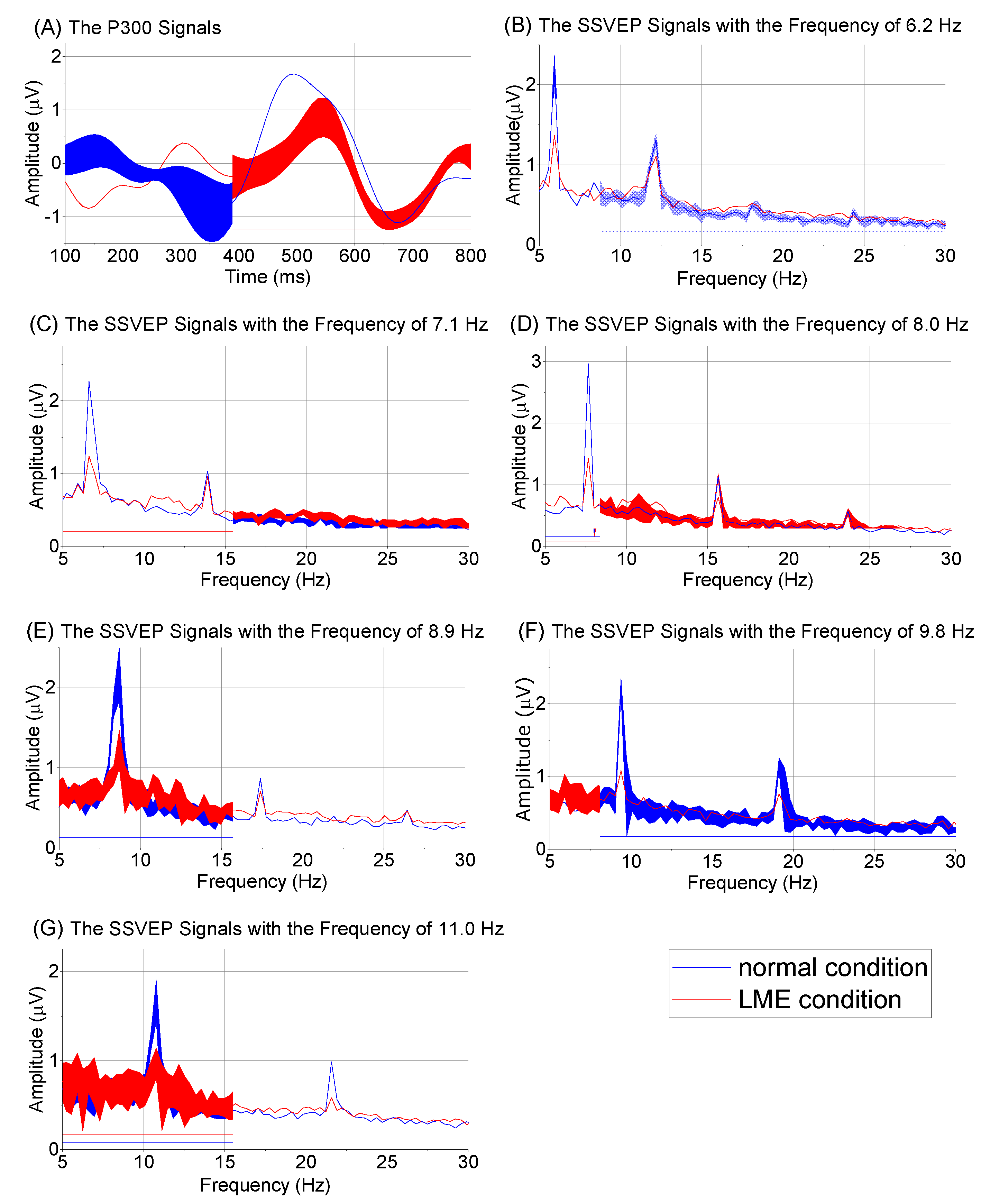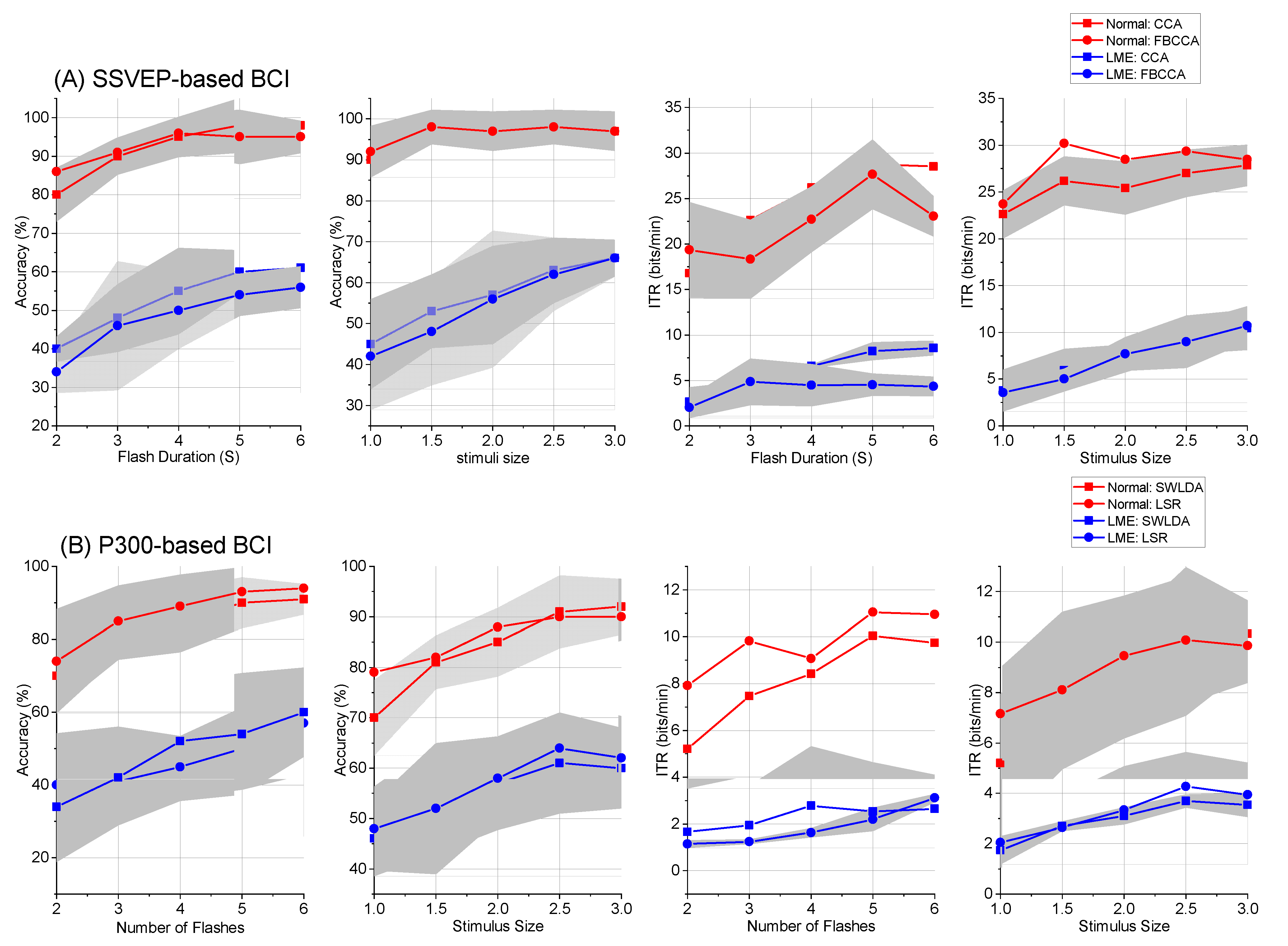Effects of Low Mental Energy from Long Periods of Work on Brain-Computer Interfaces
Abstract
:1. Introduction
2. Materials and Methods
- A.
- Subjects
- B.
- Architecture of the BCIs
- C.
- Experimental Procedure
- D.
- Task Load and Fatigue Degree
- E.
- EEG Collection and Preprocessing
- F.
- Metrics
- (i)
- BCI performance (accuracy and ITR): Relevant studies often use the ITR and accuracy to evaluate the performance of BCIs [19]. In this study, we also used the ITR and accuracy as performance metrics. Equations (8) and (9) show the method to compute the ITR. N is the number of options, which was set to 6, p is the accuracy, and T is the time required for decoding a target.
- (ii)
- EEG indices (amplitude and SNR): Studies have suggested that the amplitude and SNR of evoked EEG signals are associated with the performance of BCIs [20,40]. According to [27,41], the SNR of a P300 signal can be computed with Equations (10) and (11). In the two equations, k denotes the flash. , , and are the recorded EEG signal in the flash, the true P300 signal in the flash, and the uncorrelated noise components in the flash, respectively. denotes the mathematical expectation operator, namely, the computed mean signal of all flashes. The mean of the noise component was assumed to be zero, and returned the true P300 signal. computed the variance in the signals over time.
- G.
- Statistical Analysis
3. Results
- A.
- Performance of the BCIs
- B.
- EEG Signals in Normal and LME Conditions
- C.
- NASA-TLX and Fatigue Questionnaire Scores
- D.
- Effects of Flash Duration, Flash Number, and Stimulus Size
4. Discussion
5. Conclusions
Author Contributions
Funding
Institutional Review Board Statement
Informed Consent Statement
Data Availability Statement
Acknowledgments
Conflicts of Interest
References
- Donchin, E.; Spencer, K.M. The mental prosthesis: Assessing the speed of a P300-based brain-computer interface. IEEE Trans. Rehabil. Eng. 2000, 8, 174–179. [Google Scholar] [CrossRef] [PubMed]
- Rezeika, A.; Benda, M.; Stawicki, P.; Gembler, F.; Saboor, A.; Volosyak, I. Brain–Computer Interface Spellers: A Review. Brain Sci. 2018, 8, 57. [Google Scholar] [CrossRef] [PubMed]
- Mak, J.; Wolpaw, J. Clinical Applications of Brain-Computer Interfaces: Current State and Future Prospects. IEEE Rev. Biomed. Eng. 2009, 2, 187–199. [Google Scholar] [CrossRef] [PubMed]
- Zhang, R.; Li, Y. Control of a Wheelchair in an Indoor Environment Based on a Brain–Computer Interface and Automated Navigation. IEEE Trans. Neural Syst. Rehabil. Eng. 2016, 24, 128–139. [Google Scholar] [CrossRef]
- Yu, Y.; Liu, Y.; Jiang, J.; Yin, E.; Zhou, Z.; Hu, D. An Asynchronous Control Paradigm Based on Sequential Motor Imagery and Its Application in Wheelchair Navigation. IEEE Trans. Neural Syst. Rehabil. Eng. 2018, 26, 2367–2375. [Google Scholar] [CrossRef]
- Hochberg, L.R.; Bacher, D.; Jarosiewicz, B.; Masse, N.Y.; Simeral, J.D.; Vogel, J.; Haddadin, S.; Liu, J.; Cash, S.S.; Patrick, V. Reach and grasp by people with tetraplegia using a neurally controlled robotic arm. Nature 2013, 485, 372–375. [Google Scholar] [CrossRef]
- Chen, X.; Huang, X.; Wang, Y.; Gao, X. Combination of Augmented Reality Based Brain-Computer Interface and Computer Vision for High-Level Control of A Robotic Arm. IEEE Trans. Neural Syst. Rehabil. Eng. 2020, 28, 3140–3147. [Google Scholar] [CrossRef]
- Yee, J.K.; Marcia, G.; Ken, P.; Krishnakumar, M.; Satoru, S. Attention induces synchronization-based response gain in steady-state visual evoked potentials. Nat. Neurosci. 2007, 10, 117–125. [Google Scholar]
- Russo, F.D.; Spinelli, D. Electrophysiological evidence for an early attentional mechanism in visual processing in humans. Vis. Res. 1999, 39, 2975–2985. [Google Scholar] [CrossRef]
- Myrden, A.; Chau, T. A Passive EEG-BCI for Single-Trial Detection of Changes in Mental State. IEEE Trans. Neural Syst. Rehabil. Eng. 2017, 25, 345–356. [Google Scholar] [CrossRef]
- Lieberman, H.R. Cognitive methods for assessing mental energy. Nutr. Neurosci. 2007, 10, 229–242. [Google Scholar] [CrossRef] [PubMed]
- Joyce, E.; Blumenthal, S.; Wessely, S. Memory, attention, and executive function in chronic fatigue syndrome. J. Neurol. Neurosurg. Psychiatry 1996, 60, 495–503. [Google Scholar] [CrossRef] [PubMed]
- Borghini, G.; Astolfi, L.; Vecchiato, G.; Mattia, D.; Babiloni, F. Measuring neurophysiological signals in aircraft pilots and car drivers for the assessment of mental workload, fatigue and drowsiness. Neurosci. Biobehav. Rev. 2014, 44, 58–75. [Google Scholar] [CrossRef] [PubMed]
- Müller, T.; Klein-Flügge, M.C.; Manohar, S.G.; Husain, M.; Apps, M.A.J. Neural and computational mechanisms of momentary fatigue and persistence in effort-based choice. Nat. Commun. 2021, 12, 4593–4607. [Google Scholar] [CrossRef]
- Lim, J.; Dinges, D.F. A meta-analysis of the impact of short-term sleep deprivation on cognitive variables. Psychol. Bull. 2010, 136, 375–389. [Google Scholar] [CrossRef]
- Rashtchi, M.; Abbaszadeh, M.; Tabarraee, N. Reading Comprehension Testing Techniques and Cognitive Fatigue: A Study on Construct Irrelevant Factors. Br. J. Educ. Soc. Behav. Sci. 2015, 6, 196–209. [Google Scholar] [CrossRef]
- Dimitrakopoulos, G.N.; Kakkos, I.; Dai, Z.; Wang, H.; Sgarbas, K.; Thakor, N.; Bezerianos, A.; Sun, Y. Functional connectivity analysis of mental fatigue reveals different network topological alterations between driving and vigilance tasks. IEEE Trans. Neural Syst. Rehabil. Eng. 2018, 26, 740–749. [Google Scholar] [CrossRef]
- Li, Z.; Zhang, M.; Zhang, X. Assessment of cerebral oxygenation during prolonged simulated driving using near infrared spectroscopy: Its implications for fatigue development. Eur. J. Appl. Physiol. 2009, 107, 281–287. [Google Scholar] [CrossRef]
- Li, Y.; Pan, J.; Wang, F.; Yu, Z. A Hybrid BCI System Combining P300 and SSVEP and Its Application to Wheelchair Control. IEEE Trans. Biomed. Eng. 2013, 60, 3156–3166. [Google Scholar] [CrossRef]
- Ke, Y.; Liu, P.; An, X.; Song, X.; Ming, D. An online SSVEP-BCI system in an optical see-through augmented reality environment. J. Neural Eng. 2020, 17, 016066. [Google Scholar] [CrossRef]
- Fukuda, K.; Straus, S.E.; Hickie, I. The Chronic Fatigue Syndrome: A Comprehensive Approach to Its Definition and Study. Ann. Intern. Med. 1994, 121, 953–959. [Google Scholar] [CrossRef] [PubMed]
- Amanda, R.; Simon, W.; Trudie, C.; Andrew, P.; Anthony, C. Salivary cortisol response to awakening in chronic fatigue syndrome. Br. J. Psychiatry 2004, 184, 136–141. [Google Scholar] [CrossRef]
- Rezazadeh, I.M.; Firoozabadi, M.; Hu, H.; Golpayegani, S. Co-Adaptive and Affective Human-Machine Interface for Improving Training Performances of Virtual Myoelectric Forearm Prosthesis. IEEE Trans. Affect. Comput. 2012, 3, 285–297. [Google Scholar] [CrossRef]
- Hart, S.G.; Staveland, L.E. Development of NASA-TLX (Task Load Index): Results of Empirical and Theoretical Research. Adv. Psychol. 1988, 52, 139–183. [Google Scholar] [CrossRef]
- Proctor, R.W.; Schneider, D.W. Hick’s Law for Choice Reaction Time: A Review. Q. J. Exp. Psychol. 2017, 7, 1281–1299. [Google Scholar] [CrossRef]
- Zhang, N.; Zhou, Z.; Liu, Y.; Yin, E.; Jiang, J.; Hu, D. A novel single-character visual BCI paradigm with multiple active cognitive tasks. IEEE Trans. Biomed. Eng. 2019, 66, 3119–3128. [Google Scholar] [CrossRef]
- Pires, G.; Nunes, U.; Castelo, M. Comparison of a row-column speller vs. a novel lateral single-character speller: Assessment of BCI for severe motor disabled patients. Clin. Neurophysiol. Off. J. Int. Fed. Clin. Neurophysiol. 2012, 123, 1168–1181. [Google Scholar] [CrossRef]
- Lenhardt, A.; Kaper, M.; Ritter, H. An Adaptive P300-Based Online Brain–Computer Interface. IEEE Trans. Neural Syst. Rehabil. Eng. 2008, 16, 121–130. [Google Scholar] [CrossRef]
- Bin, G.; Gao, X.; Yan, Z.; Hong, B.; Gao, S. An online multi-channel SSVEP-based brain-computer interface using a canonical correlation analysis method. J. Neural Eng. 2009, 6, 046002. [Google Scholar] [CrossRef]
- Chen, X.; Wang, Y.; Nakanishi, M.; Gao, X.; Jung, T.-P.; Gao, S. High-speed spelling with a noninvasive brain-computer interface. Proc. Natl. Acad. Sci. USA 2015, 4 24, E6058. [Google Scholar] [CrossRef]
- Brunner, P.; Joshi, S.K. Does the ‘P300′ speller depend on eye gaze? J. Neural Eng. 2010, 7, 13–22. [Google Scholar] [CrossRef] [Green Version]
- Schalk, G.; McFarland, D.J.; Hinterberger, T.; Birbaumer, N.; Wolpaw, J.R. BCI2000: A general-purpose brain-computer interface (BCI) system. IEEE Trans. Biomed. Eng. 2004, 51, 1034–1043. [Google Scholar] [CrossRef]
- Krusienski, D.J.; Sellers, E.W.; Cabestaing, F.O.; Bayoudh, S.; Mcfarland, D.J.; Vaughan, T.M.; Wolpaw, J.R. A comparison of classification techniques for the P300 Speller. J. Neural Eng. 2006, 3, 299–305. [Google Scholar] [CrossRef]
- Nike, W.; Thilo, H. Determining states of consciousness in the electroencephalogram based on spectral, complexity, and criticality features. Neuroscience of Consciousness. 2022, 1, 8–27. [Google Scholar]
- Yin, E.; Zhou, Z.; Jiang, J. A speedy hybrid BCI spelling approach combining P300 and SSVEP. IEEE Trans. Biomed. Eng. 2014, 61, 473–483. [Google Scholar] [CrossRef] [PubMed]
- Lin, Z.; Zhang, C.; Wu, W.; Gao, X. Frequency Recognition Based on Canonical Correlation Analysis for SSVEP-Based BCIs. IEEE Trans. Biomed. Eng. 2007, 54, 1172–1176. [Google Scholar] [CrossRef] [PubMed]
- Chen, X.; Wang, Y.; Gao, S.; Jung, T.P.; Gao, X. Filter bank canonical correlation analysis for implementing a high-speed SSVEP-based brain-computer interface. J. Neural Eng. 2015, 12, 046008. [Google Scholar] [CrossRef] [PubMed]
- Dosovitskiy, A.; Ros, G.; Codevilla, F.; López, A.; Koltun, V. CARLA: An Open Urban Driving Simulator. In Proceedings of the 1st Conference on Robot Learning, Mountain View, CA, USA, 10 November 2017. [Google Scholar]
- Johnston, D.; Allan, J.; Powell, D.; Jones, M. Why does work cause fatigue? A real-time investigation of fatigue, and determinants of fatigue in nurses working 12-h shifts. Ann. Behav. Med. 2018, 53, 551–562. [Google Scholar] [CrossRef]
- Chen, X.; Chen, Z.; Gao, S.; Gao, X. Brain-computer interface based on intermodulation frequency. J. Neural Eng. 2013, 10, 66009. [Google Scholar] [CrossRef] [PubMed]
- Lemm, S.; Curio, G.; Hlushchuk, Y.; Müller, K.-R. Enhancing the Signal-to-Noise Ratio of ICA-Based Extracted ERPs. IEEE Trans. Biomed. Eng. 2006, 53, 601–607. [Google Scholar] [CrossRef]
- Guner, B.; Frankford, M.T.; Johnson, J.T. A Study of the Shapiro-Wilk Test for the Detection of Pulsed Sinusoidal Radio Frequency Interference. IEEE Trans. Geosci. Remote Sens. 2009, 47, 1745–1751. [Google Scholar] [CrossRef]
- Stefanidis, D.; Wang, F.; Korndorffer, J.R.; Dunne, J.B.; Scott, D.J. Robotic assistance improves intracorporeal suturing performance and safety in the operating room while decreasing operator workload. Surg. Endosc. 2010, 24, 377–382. [Google Scholar] [CrossRef] [PubMed]
- Yu, Y.; Zhou, Z.; Liu, Y.; Jiang, J.; Yin, E.; Zhang, N. Self-Paced Operation of a Wheelchair Based on a Hybrid Brain-Computer Interface Combining Motor Imagery and P300 Potential. IEEE Trans. Neural Syst. Rehabil. Eng. 2017, 25, 2516–2526. [Google Scholar] [CrossRef] [PubMed]
- Codispoti, M.; Cesarei, A.D. Arousal and attention: Picture size and emotional reactions. Psychophysiology 2007, 44, 680–686. [Google Scholar] [CrossRef] [PubMed]
- Bernardo, D.S.; Matteo, M.; Luca, T.M. The Utility Metric: A Novel Method to Assess the Overall Performance of Discrete Brain–Computer Interfaces. IEEE Trans. Neural Syst. Rehabil. Eng. 2010, 18, 20–28. [Google Scholar] [CrossRef]
- Busch, N.A.; Debener, S.; Kranczioch, C.; Engel, A.K.; Herrmann, C.S. Size matters: Effects of stimulus size, duration and eccentricity on the visual gamma-band response. Clin. Neurophysiol. 2004, 115, 1810–1820. [Google Scholar] [CrossRef]
- Zhu, D.; Bieger, J.; Molina, G.G.; Aarts, R.M. A Survey of Stimulation Methods Used in SSVEP-Based BCIs. Comput. Intell. Neurosci. 2010, 10, 702–714. [Google Scholar] [CrossRef]
- Vuilleumier, P.; Henson, R.N.; Driver, J.; Dolan, R.J. Multiple levels of visual object constancy revealed by event-related fMRI of repetition priming. Nat. Neurosci. 2002, 5, 491–499. [Google Scholar] [CrossRef]
- Furmanski, C.S.; Engel, S.A. Perceptual learning in object recognition: Object specificity and size invariance. Vis. Res. 2000, 40, 473–484. [Google Scholar] [CrossRef]
- Ashbridge, E.; Perrett, D.I.; Oram, M.W.; Jellema, T. Effect of Image Orientation and Size on Object Recognition: Responses of Single Units in the Macaque Monkey Temporal Cortex. Cogn. Neuropsychol. 2000, 17, 13–34. [Google Scholar] [CrossRef]
- Hogan, P.S.; Chen, S.X.; Chib, V.S. Neural mechanisms underlying the effects of physical fatigue on effort-based choice. Nat. Commun. 2020, 11, 26. [Google Scholar] [CrossRef] [PubMed]
- Lu, Y.; Bi, L. Combined Lateral and Longitudinal Control of EEG Signals-Based Brain-Controlled Vehicles. IEEE Trans. Neural Syst. Rehabil. Eng. 2019, 27, 1732–1742. [Google Scholar] [CrossRef] [PubMed]
- Chai, X.; Zhang, Z.; Guan, K.; Zhang, T.; Niu, H. Effects of Fatigue on Steady State Motion Visual Evoked Potentials: Optimised Stimulus Parameters for a Zoom Motion-based Brain-Computer Interface. Comput. Methods Programs Biomed. 2020, 196, 105–125. [Google Scholar] [CrossRef] [PubMed]
- Xie, J.; Xu, G.; Jing, W.; Zhang, F.; Zhang, Y.; Gennady, C. Steady-State Motion Visual Evoked Potentials Produced by Oscillating Newton’s Rings: Implications for Brain-Computer Interfaces. PLoS ONE 2012, 7, 707–714. [Google Scholar] [CrossRef]
- Tsuchimoto, S.; Shibusawa, S.; Iwama, S.; Hayashi, M.; Okuyama, K. Use of common average reference and large-Laplacian spatial-filters enhances EEG signal-to-noise ratios in intrinsic sensorimotor activity. J. Neurosci. Methods 2021, 353, 109089. [Google Scholar] [CrossRef]
- Mubarok, M.; Mengko, T.; Prihatmanto, A.; Indrayanto, D. Implementation of small laplacian spatial filter for MU rhythm acquisition in BCI2000. In Proceedings of the International Conference of System Engineering and Technology (ICSET), Bandung, Indonesia, 24 November 2014; p. 15180055. [Google Scholar]
- Ramos, J.; Guevara, M.; Arce, C. Effect of total sleep deprivation on reaction time and waking EEG activity in man. Sleep 1995, 18, 346–354. [Google Scholar]
- Murphy, M.; Peterson, M. Sleep Disturbances in Depression. Sleep Med. Clin. 2015, 10, 17–23. [Google Scholar] [CrossRef] [Green Version]







| Subjects | Sex | Accuracy (%) by SWLDA Decoding | ITR (Bits/min) by SWLDA Decoding | Accuracy (%) by LSR Decoding | ITR (Bits/min) by LSR Decoding | ||||
|---|---|---|---|---|---|---|---|---|---|
| Normal | LME | Normal | LME | Normal | LME | Normal | LME | ||
| S1 | Female | 83.3 | 46.7 | 8.0 | 1.8 | 80.0 | 33.3 | 7.2 | 0.6 |
| S2 | Female | 100.0 | 40.0 | 13.4 | 1.1 | 83.3 | 43.3 | 8.0 | 1.5 |
| S3 | Male | 76.7 | 43.3 | 6.5 | 1.5 | 90.3 | 46.7 | 9.8 | 1.8 |
| S4 | Female | 80.0 | 56.7 | 7.2 | 3.1 | 93.0 | 57.0 | 10.6 | 3.1 |
| S5 | Male | 73.3 | 46.7 | 5.8 | 1.8 | 100.0 | 50.0 | 13.4 | 2.2 |
| S6 | Male | 70.0 | 43.3 | 5.2 | 1.5 | 80.3 | 50.0 | 7.3 | 2.2 |
| S7 | Male | 93.3 | 56.7 | 10.7 | 3.1 | 83.0 | 33.3 | 7.9 | 0.6 |
| S8 | Male | 70.0 | 46.7 | 5.2 | 1.8 | 76.0 | 36.7 | 6.4 | 0.8 |
| S9 | Female | 80.0 | 36.7 | 7.2 | 0.9 | 73.0 | 40.0 | 5.8 | 1.1 |
| S10 | Male | 86.7 | 46.7 | 8.8 | 1.8 | 76.6 | 46.0 | 6.5 | 1.7 |
| Mean ± SD | - | 81.3 ± 9.8 | 46.4 ± 6.4 * | 7.8 ± 2.6 | 1.8 ± 0.7 * | 83.4 ± 8.5 | 43.6 ± 7.9 * | 8.3 ± 2.3 | 1.6 ± 0.8 * |
| Subjects | Sex | Accuracy (%) by CCA Decoding | ITR (Bits/min) by CCA Decoding | Accuracy (%) by FBCCA Decoding | ITR (Bits/min) by FBCCA Decoding | ||||
|---|---|---|---|---|---|---|---|---|---|
| Normal | LME | Normal | LME | Normal | LME | Normal | LME | ||
| S1 | Female | 83.3 | 56.7 | 18.6 | 7.1 | 90.0 | 53.0 | 22.6 | 6.0 |
| S2 | Female | 93.3 | 50.0 | 24.9 | 5.1 | 90.6 | 52.3 | 23.0 | 5.7 |
| S3 | Male | 93.3 | 53.3 | 24.9 | 6.0 | 93.0 | 57.7 | 24.7 | 7.4 |
| S4 | Female | 86.7 | 36.7 | 20.5 | 2.0 | 100.0 | 66.3 | 31.0 | 10. 6 |
| S5 | Male | 90.0 | 40.0 | 22.6 | 2.7 | 90.3 | 52.7 | 22.8 | 5.9 |
| S6 | Male | 86.7 | 36.7 | 20.5 | 2.0 | 100.0 | 40.3 | 31.0 | 2.7 |
| S7 | Male | 93.3 | 56.7 | 24.9 | 7.1 | 86.7 | 49.7 | 20.5 | 5.0 |
| S8 | Male | 86.7 | 33.3 | 20.5 | 1.4 | 95.0 | 50.0 | 26.2 | 5.1 |
| S9 | Female | 96.7 | 60.0 | 27.6 | 8.2 | 93.0 | 66.7 | 24.7 | 10.7 |
| S10 | Male | 100.0 | 63.3 | 31.0 | 9.4 | 94.7 | 49.0 | 26.0 | 4.8 |
| Mean ± SD | - | 91.0 ± 5.2 | 48.7 ± 11.0 * | 23.6 ± 3.8 | 5.1 ± 2.9 * | 93.3 ± 4.3 | 53.7 ± 8.0 * | 25.2 ± 3.5 | 6.4 ± 2.5 * |
| Subjects | Mental Demand | Physical Demand | Temporal Demands | Frustration | Effort | Performance | ||||||
|---|---|---|---|---|---|---|---|---|---|---|---|---|
| Normal | LME | Normal | LME | Normal | LME | Normal | LME | Normal | LME | Normal | LME | |
| S1 | 50 | 85 | 50 | 85 | 40 | 90 | 45 | 95 | 50 | 75 | 50 | 85 |
| S2 | 50 | 90 | 55 | 90 | 60 | 80 | 35 | 100 | 40 | 90 | 45 | 95 |
| S3 | 35 | 95 | 35 | 90 | 45 | 85 | 25 | 95 | 50 | 90 | 45 | 90 |
| S4 | 35 | 90 | 40 | 95 | 45 | 80 | 40 | 90 | 40 | 90 | 40 | 95 |
| S5 | 45 | 80 | 45 | 85 | 35 | 85 | 50 | 85 | 55 | 90 | 45 | 80 |
| S6 | 35 | 90 | 35 | 100 | 30 | 95 | 25 | 95 | 50 | 85 | 30 | 90 |
| S7 | 35 | 80 | 25 | 80 | 35 | 90 | 40 | 75 | 35 | 75 | 35 | 80 |
| S8 | 25 | 85 | 15 | 80 | 15 | 90 | 20 | 75 | 30 | 75 | 15 | 90 |
| S9 | 15 | 70 | 5 | 60 | 5 | 60 | 10 | 55 | 15 | 50 | 5 | 70 |
| S10 | 15 | 70 | 25 | 60 | 10 | 80 | 20 | 75 | 25 | 75 | 15 | 70 |
| Mean ± SD | 34.0 ± 12.6 * | 83.5 ± 8.5 | 33.0 ± 15.7 * | 82.5 ± 13.4 | 32.0 ± 17.4 * | 83.5 ± 9.7 | 31.0 ± 13.0 * | 84.0 ± 14.0 | 39.0 ± 13.0 * | 80.0 ± 12.6 | 32.5 ± 15.7 * | 84.5 ± 9.3 |
| Subjects | Physical Fatigue | Mental Fatigue | ||
|---|---|---|---|---|
| Normal | LME | Normal | LME | |
| S1 | 13 | 88 | 34 | 67 |
| S2 | 25 | 88 | 34 | 67 |
| S3 | 13 | 88 | 17 | 50 |
| S4 | 13 | 100 | 50 | 50 |
| S5 | 45 | 100 | 50 | 67 |
| S6 | 25 | 75/ | 34 | 67 |
| S7 | 20 | 75 | 34 | 67 |
| S8 | 25 | 88 | 17 | 67 |
| S9 | 15 | 75 | 17 | 67 |
| S10 | 10 | 75 | 34 | 50 |
| Mean ± SD | 20.4 ± 10.4 * | 85.2 ± 9.9 | 32.1 ± 12.2 * | 62.0 ± 8.2 |
Publisher’s Note: MDPI stays neutral with regard to jurisdictional claims in published maps and institutional affiliations. |
© 2022 by the authors. Licensee MDPI, Basel, Switzerland. This article is an open access article distributed under the terms and conditions of the Creative Commons Attribution (CC BY) license (https://creativecommons.org/licenses/by/4.0/).
Share and Cite
Liu, K.; Yu, Y.; Zeng, L.-L.; Liang, X.; Liu, Y.; Chu, X.; Lu, G.; Zhou, Z. Effects of Low Mental Energy from Long Periods of Work on Brain-Computer Interfaces. Brain Sci. 2022, 12, 1152. https://doi.org/10.3390/brainsci12091152
Liu K, Yu Y, Zeng L-L, Liang X, Liu Y, Chu X, Lu G, Zhou Z. Effects of Low Mental Energy from Long Periods of Work on Brain-Computer Interfaces. Brain Sciences. 2022; 12(9):1152. https://doi.org/10.3390/brainsci12091152
Chicago/Turabian StyleLiu, Kaixuan, Yang Yu, Ling-Li Zeng, Xinbin Liang, Yadong Liu, Xingxing Chu, Gai Lu, and Zongtan Zhou. 2022. "Effects of Low Mental Energy from Long Periods of Work on Brain-Computer Interfaces" Brain Sciences 12, no. 9: 1152. https://doi.org/10.3390/brainsci12091152





